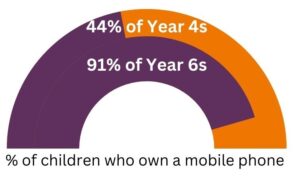Safer Internet Day February 2023
By Kirsty Ruthven, Head of Education
A recent report by Ofcom highlights a range of new information around the online worlds of children. 95% of 8- to 11-year-olds used video sharing platforms (VSPs) such as YouTube and TikTok in 2021. The majority of children this age also had an account on at least one social media site.
Recent publicity has also given rise to concerns around online influencers. One example being Andrew Tate who promotes misogynistic and hateful narratives.
Online influencers, people who promote goods and services online, are regularly viewed by 4 in 10 children under 18. A range of research demonstrates that influencers receive higher levels of trustworthiness than other forms of media. This can then lead to concerns around the ability of children to safely navigate the online world.
Cyberbullying, discriminatory content, unhealthy eating and adverse effects on mental health for children have been associated with online use.
“Schools and colleges play a crucial role in preventative education”
Keeping Children Safe in Education 2022, Department of Education
Not all online behaviours can be attributed to harmful outcomes. However, schools clearly play an important role around internet safety and the development of digital literacies in children.
How can parents and teachers support primary-aged children to navigate the world of online influencers?
Lifting Limits has written guidelines for parents and teachers and shared with the schools we work with.
The main headlines are…
- Support children to separate fact from fiction
Videos can be heavily curated and edited, support children to understand that the online world is not the real world.
- Watch what they watch
Ask what children are watching. Challenge children to explain the content to someone who has never watched it in three sentences or less.
- Challenge gender stereotypes
Limiting gender stereotypes can be harmful for children now and in later life. Some online content can subscribe to strong views around gender whilst other gender stereotypes might be harder to spot.
- Remember appropriate age limits for online platforms
Most recommended platforms advise that only children who are 13 or above use them.
- Take it all seriously
Children may not have directly seen content by key influencers but may be aware of the content or language used. Support children to see that some language, even if it is meant as a joke, can still be upsetting and damaging.
- Explain how social media platforms work
Algorithms steers content that a platform will show you. This can sometimes mean emotion-driven videos or stories entice children to stay online for longer.
- Share that everyone can be affected negatively
Harmful messages harm everyone of all genders. The normalisation of this messaging online is detrimental to wider society.
How can Lifting Limits help?
We provide the training and resources educators need to make visible, for challenge and discussion, gender stereotyping which may exist in the school environment and to equip their pupils to challenge gender stereotyping wherever they encounter it in the wider world.
References
- An, S., and Ha, S., (2022) When influencers promote unhealthy products and behaviours: the role of ad disclosures in YouTube eating shows, International Journal of Advertising
- Bjørgen, A.M., and Erstad, O., (2015) The connected child: tracing digital literacy from school to leisure, Pedagogies: An International Journal, 10:2, 113-127
- Department for Education (2022) Keeping Children Safe in Education.: Statutory Guidance for Schools and Colleges
- Fan, F., & Chan, K., (2022) From a Relational Approach: The Persuasiveness of Advertisements Endorsed by Celebrities and Online Influencers, Journal of Promotion Management
- Livingstone, S., Haddon, L., Vincent, J., Mascheroni, G. and Olafsson, K. (2014) Net children go mobile: The UK report. London: LSE
- Ofcom (2021). Children and parents: media use and attitudes report 2022. London: Office of Communications
- Peter J. R. Macaulay, J.R., Boulton, M.J., Betts, L.R., Boulton L., Camerone, E., Down, J., Hughes, J., Kirkbride, C., Kirkham, R (2020). Subjective versus objective knowledge of online safety/dangers as predictors of children’s perceived online safety and attitudes towards e-safety education in the United Kingdom, Journal of Children and Media, 14:3, 376-395
- PSHE Association (2023) Addressing misogyny, toxic masculinity and social media influence through PSHE education. Available at Addressing misogyny, toxic masculinity and social media influence in PSHE education (pshe-association.org.uk)
- Roberts, M. (2023). How to respond to boys inspired by Andrew Tate. Available at How to respond to boys inspired by Andrew Tate | Tes

